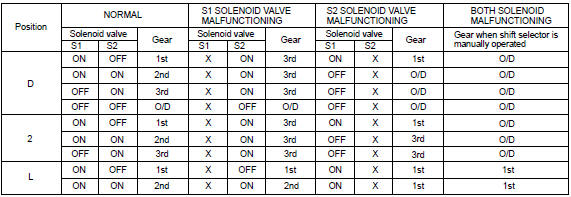Toyota Corolla (E120): Circuit description
Shifting from 1st to o/d is performed in combination with on and off of the shift solenoid valve s1 and s2 controlled by ecm. If an open or short circuit occurs in either of the solenoid valves, the ecm controls the remaining normal solenoid valve to allow the vehicle to be operated smoothly (fail safe function).
Fail safe function: if either of the solenoid valve circuits develops an open or short, the ecm turns the other solenoid valve on and off to shift to the gear positions shown in the table below. If both solenoids malfunction, hydraulic control cannot be performed electronically and must be done manually.
Manual shifting as shown in the above table must be done (in the case of a short circuit, the ecm stops sending current to the short circuited solenoid).

X: malfunctions

Monitor description
The ecm commands gearshift by turning the shift solenoid valves ”on/off”. When there is an open or short circuit in any shift solenoid valve circuit, the ecm detects the problem and the mil comes on. Illuminating the mil, the ecm performs the fail–safe and turns the other shift solenoid valves in good condition ”on/off” (in case of an open or short circuit, the ecm stops sending current to the circuit.).
Monitor strategy

Typical enabling condition

Typical malfunction thresholds

Component operating range

Wiring diagram

Other materials:
Spiral cable sub–assy
Components
Replacement
Hint: components:
1. Precaution
2. Disconnect battery negative terminal
3. Place front wheels facing straight ahead
check that the front wheels are facing straight ahead.
4. Remove horn button assy
5. Remove steering wheel assy
sst 09950–50013 ...
Replacement
1. Remove battery
2. Remove battery carrier
Remove the 4 bolts and battery carrier.
3. Disconnect floor shift cable transmission control shift
Remove the nut from the control shaft lever.
disconnect the control cable from the control shaft lever.
remove the clip a ...
Location of the spare tire, jack and tools
1 Luggage floor cover
2 Wheel nut wrench
3 Jack handle
4 Jack attachment*
5 Jack
6 Spare tire
7 Tool tray
*: The jack attachment is used when raising your vehicle with a floor jack.
CAUTION
■Using the tire jack
Observe the following precautions.
Improper use of the tire jack may c ...


